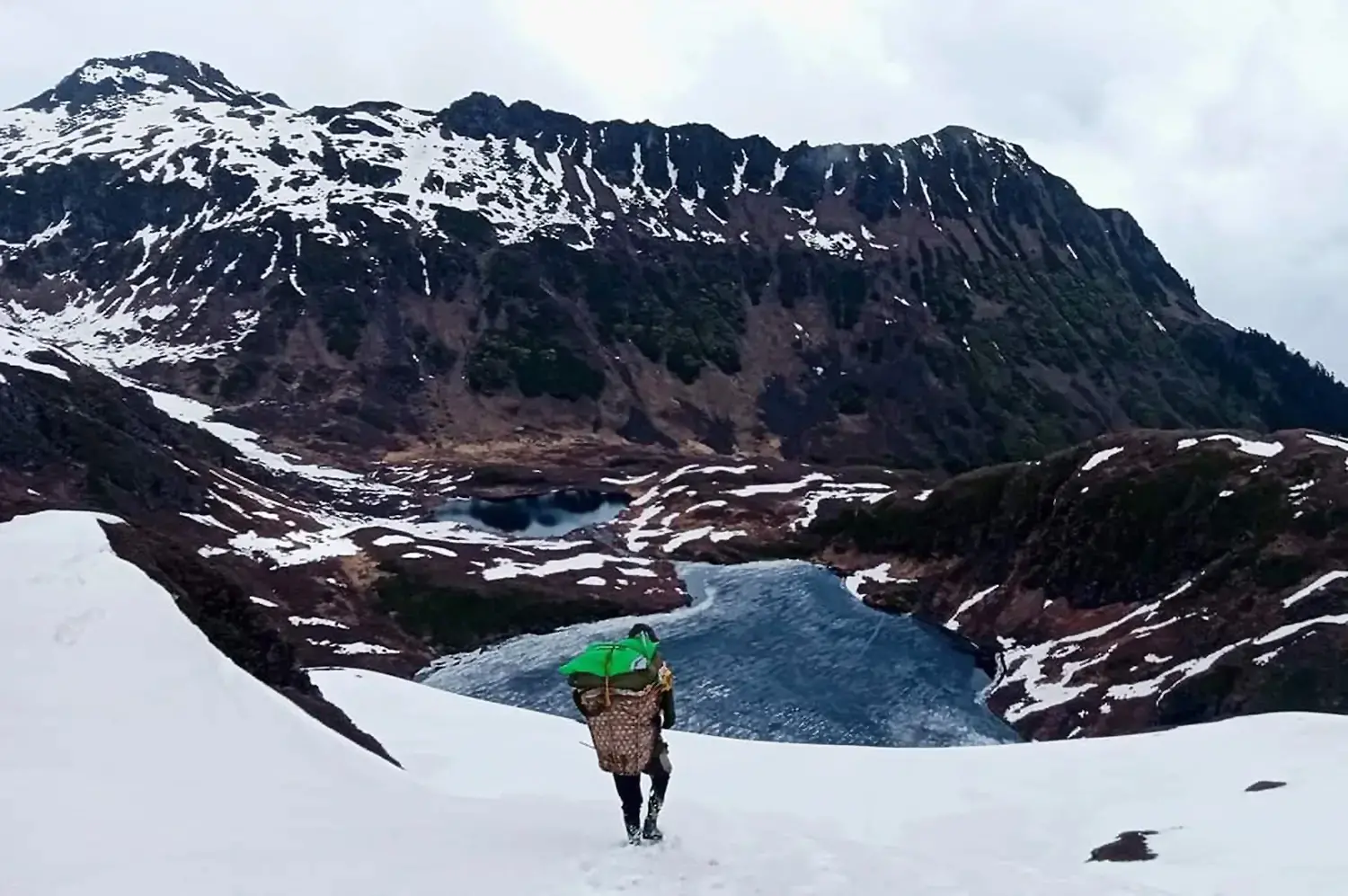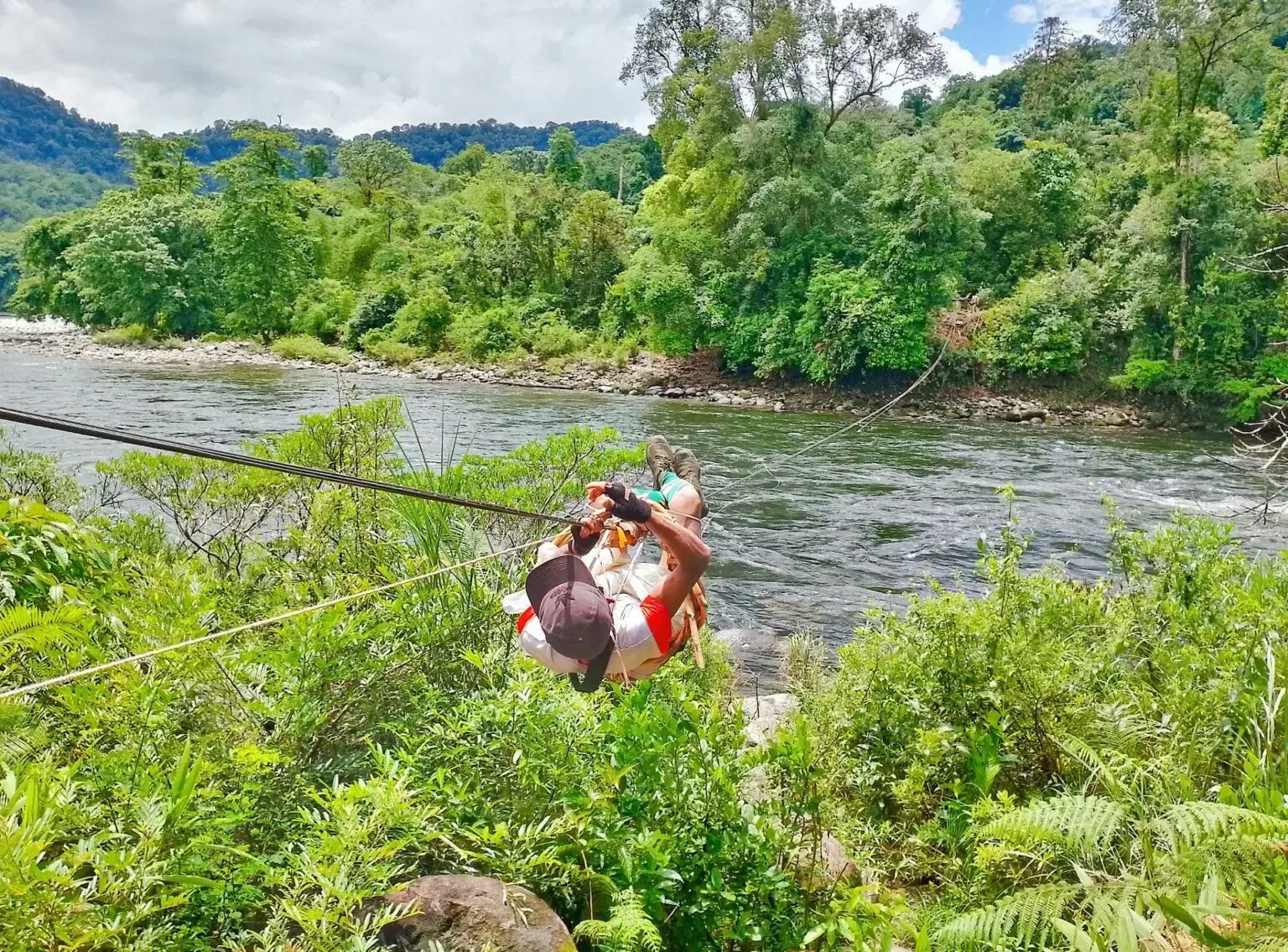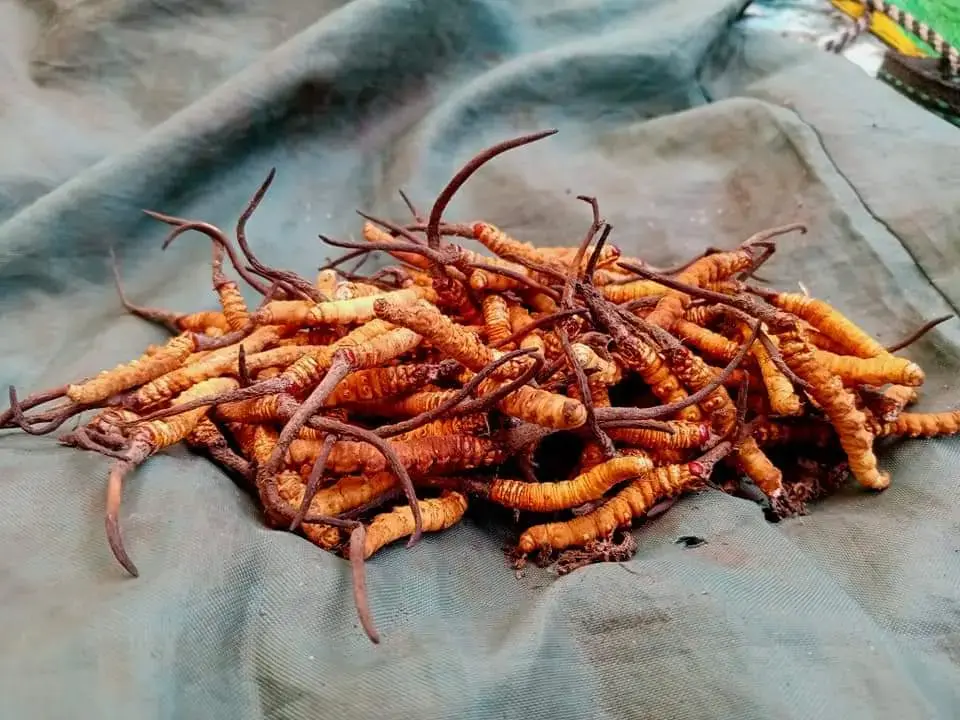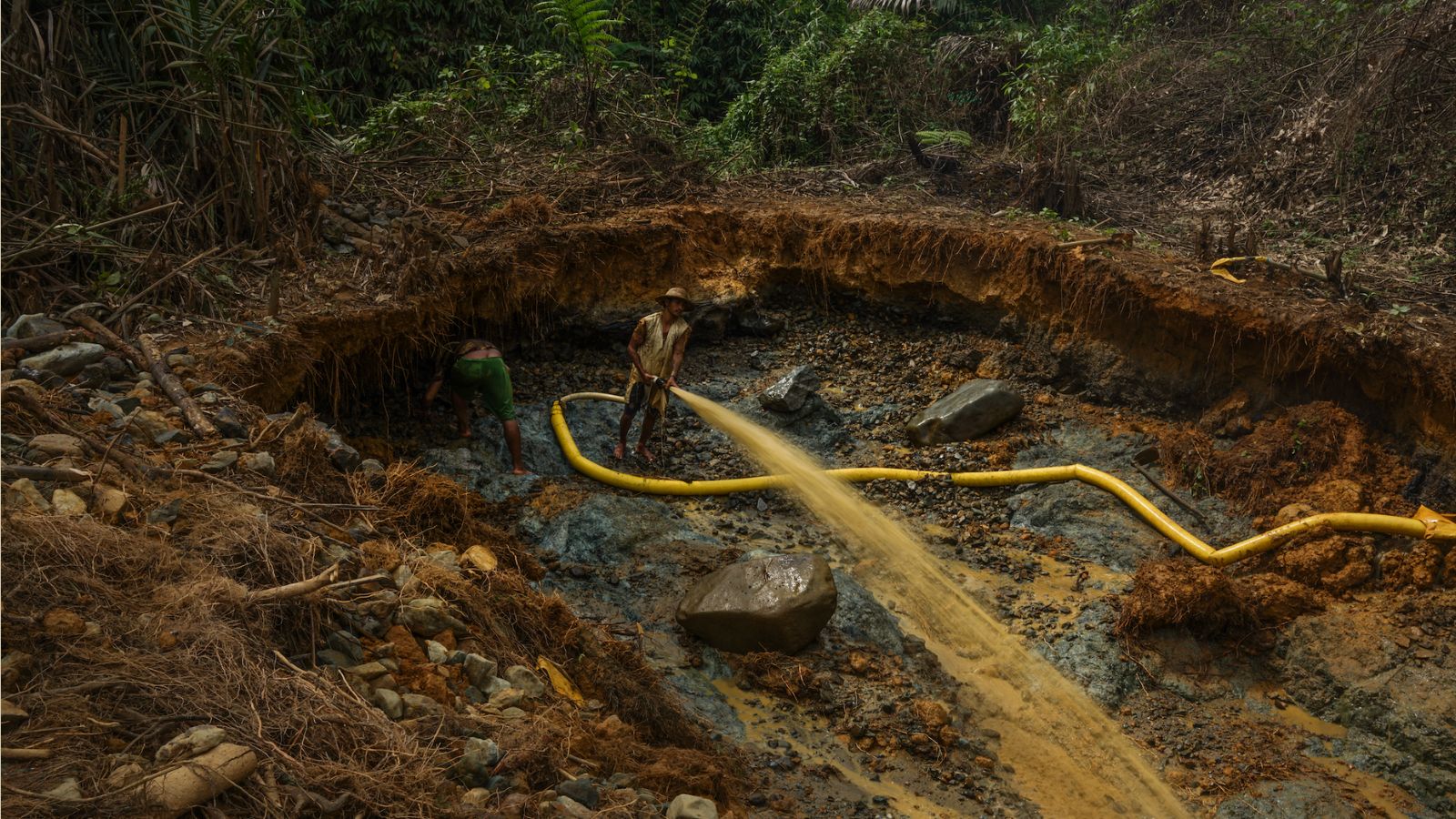
Already under strain from overharvesting and habitat degradation, Myanmar’s cordyceps fungus industry has accelerated since COVID-19 and the coup, along with the perilous search for a rare orchid root.
In April 2019, when he was 16 years old, Hmone Ram began trekking deep into the snow-capped Hkakabo Razi mountains of Kachin State’s far north. Layering up in his warmest clothes, he stuffed a head-strap basket with blankets, plastic sheeting and dry food and set off from his native town of Putao with his father, a seasoned mountaineer.
They crossed rapidly-flowing streams and climbed steep inclines, at times getting drenched by the pre-monsoon rains. To accompany their rice and instant noodles, they foraged for mushrooms and greens, used traps and a crossbow to hunt for birds and other animals, and drank from clear streams or collected ice to boil. At night, they fastened simple tents to shield themselves from the wind and freezing rain.
Although arduous, the trip was only in preparation for a longer one. After stockpiling rations in log cabins along the way, they returned to Putao for a few weeks to rest and refill their baskets before setting out again.
This time, they climbed for more than a week, until the incline levelled and the forest cleared into a grassy plateau. It’s an area locals refer to as a maw, or mine – not for its wealth of minerals, but because it serves as a habitat for the world’s most valuable parasite.
Known as yartsa gunbu (summer grass, winter worm) in Tibetan, the fungus is called shibadi in Myanmar, possibly from the Lisu word for a bamboo-eating caterpillar. It grows at altitudes of 3,000-5,000 metres in the Himalayas and Tibetan Plateau, and reproduces by taking over the bodies of burrowing caterpillars and growing a spore-filled stalk out of their heads.
Shibadi belong to the cordyceps family, which recently made its televisual debut in the HBO series “The Last of Us”, in which a variant infects humans, turns them into zombie-like creatures and drives society to collapse. In real life, cordyceps prey on insects, arthropods and other fungi, and people pay exorbitant amounts of money to consume the caterpillar-eating variety.
Used for centuries in China and Tibet to treat a range of ailments, it became commercially popular in the late 1990s. By 2018, it was selling for more than three times the price of gold and had a global market value upwards of US$5 billion. It’s one of thousands of wild plants and fungi for which global demand has surged in recent decades, largely for use in traditional medicine, in a trend that accelerated with the COVID-19 pandemic.
But while the wild harvesting industry provides a vital source of income for millions of people, including in some of the world’s most isolated places, a growing body of research warns of overharvesting, premature harvesting and habitat degradation – problems that are likely exacerbated by climate change.
These dynamics appear to be playing out in Kachin’s northern forests, where the wildlife trade was rampant even before the February 2021 military coup. Interviews with three wild plant and fungus harvesters, a local researcher and a former Forest Department worker indicate that while many species have long been in decline, the financial pressures brought on by the COVID-19 pandemic and coup have driven more people to search for them, often risking their lives in harsh and perilous conditions.
Some warned that a combination of poor resource governance and a lack of viable income-generating alternatives is likely a recipe for disaster for both the forests and the people who rely on them to survive. “If we don’t conserve or maintain our forests and icy mountains, the wildlife and plants will soon disappear,” said Min Seng, an environmental activist in Putao whose civil society organisation conducted field research on the shibadi industry from 2020 to 2022.
This research identified a “significant” increase in the search for shibadi as well as medicinal plants, and documented adverse environmental impacts. At the same time, Min Seng said that it was difficult to come up with practical solutions. “We raise awareness about maintaining our local ecosystems and we are planning to do more, but it isn’t easy,” he said. “Local people don’t have any alternatives for earning a living, so they just turn to this kind of livelihood. It’s hard to tell people they shouldn’t do it.”

‘We didn’t know it could be sold’
Kachin’s northern mountains, known by conservationists as the Hkakabo Razi Landscape or Northern Mountain Forest Complex, extend from just north of Putao to Myanmar’s borders with India’s Arunachal Pradesh, China’s Yunnan province and Tibet. A subrange of the Himalayas, it includes the 5,881-metre Hkakabo Razi mountain, likely Southeast Asia’s tallest peak, and also holds one of the world’s largest contiguous forests.
Home to a few thousand ethnic Rawang people and smaller populations of Lisus and Tibetans, these forests also provide a habitat to more than 1,100 species of amphibians, birds, mammals, butterflies, trees and orchids. This biodiversity, and its exceptional concentration of endemic and globally-threatened species, has captivated conservationists and piqued the interest of wildlife traders who mostly serve a Chinese medicinal market.
Caught in the middle are local people, who have maintained the forest for generations, while also relying on its resources for a living. Until recently, most lived in villages that are staggeringly remote. Multiple days’ walk from the nearest commercial centre and with limited or no access to telecommunication services, they turned to hunting and foraging for survival.
Phong Sar*, 72, entered the trade as a teenager. Like his parents and grandparents before him, he would hunt and forage in the forest surrounding his village and then trek up to the Tibetan border to sell his products, using the cash to buy basic goods.
His haul varied from year to year, but often included machit-u, the tiny bulbous roots of a lily known as yellow Himalayan fritillary; kan dauk myit, the root tendrils of a marigold known as coptis teeta or Yunnan goldthread; pain-u, the tuberous roots ofa flowering plant known in Burmese as sachi and in English as Paris polyphylla or love apple; and lingzhi, the Chinese name for a flat-capped mushroom known in Japanese as reishi.
Around 2005, traders started asking Phong Sar about caterpillar fungus too – a species that until then had attracted little local attention. “Before, we soaked shibadi in hot water and drank it like tea. We didn’t know it could be sold,” he said.
A few years later, when he started taking his products to Yunnan as well as Tibet, he had a new staple in his inventory – shibadi. Around the same time, he moved to Putao as part of a migration of more than 400 people – a significant portion of the population in the mountains – to the town over the last two decades, during which it became a hub for the wildlife trade and cash crops including black cardamom.
A documentary by the Kachin Development Networking Group found that the exodus from the mountains to Putao was largely driven by the Forest Department establishing the 3,810 sq km Hkakabo Razi National Park in 1998 and the 2,700 sq km Hponkan Razi Wildlife Sanctuary in 2003, thereby banning commercial hunting and foraging in these areas. Many locals felt these policies were imposed without sufficient consultation and disregarded their customary knowledge of forest management.
Grievances escalated in 2016, when the Forest Department attempted to add a 4,700 sq km “southern extension” to Hkakabo Razi National Park in order to better meet the criteria for a UNESCO World Heritage nomination. By 2017, protests had erupted in Putao and mountain villages, culminating with the burning of a Forest Department guard post a year later.
The unrest resulted in the ejection of the Forest Department and its international partner, the New York-headquartered Wildlife Conservation Society, and the suspension of the World Heritage nomination. But even through this upheaval, the wildlife trade continued. “The main sources of income for my family are medicinal plants and hunting,” said Phong Sar. “My father, my children and I all earn an income the same way. My grandchildren are still young. Maybe they will do the same when they grow up too.”

Deadly work
Hmone Ram, a third-generation shibadi harvester, was born shortly after his parents migrated from the mountains to Putao. As is common in cordyceps-harvesting areas of the Himalayas, he had just finished ninth grade when he went on his first expedition with his father in 2019.
A cheerful young man with dyed-blond hair who listens to the Korean pop band Blackpink, he spent his school holiday climbing through the rain and then painstakingly probing the snow-covered ground for stalks of shibadi, which extend a few centimetres out of the soil. Returning home, he handed over his harvest of shrivelled, orange-brown fungi to his mother and went back to school.
The pandemic hit less than a year later, shuttering schools across the country. Then in August 2020, his father died of an unknown illness while on a trip as a mountain guide for domestic tourists. Hmone Ram never went back to school and instead followed in his father’s footsteps, foraging seasonally and serving as a mountain guide and cook in the winter.
Nang Sar,* 21, is one of a relatively small number of women in the industry. Growing up in a village just a few kilometres from Kachin’s northernmost border, she attended school in Putao and joined her parents and siblings foraging for plants during her holidays. Three years ago, her Bible studies on hold due to the pandemic, she began searching for shibadi as well.
She described gruelling journeys. “I think because of the cold weather, I suffer from menstrual cramps and body aches,” she said. “Normally, we don’t shower for the two months we’re searching for shibadi. We just clean ourselves with a wet towel.”
There are many perils along the way. Besides the risks of falling sick far from a healthcare facility, getting caught in an avalanche or falling through thin ice, shibadi harvesters have to traverse fast-flowing rivers using precariously narrow footbridges or ziplines while carrying heavy loads. “I have witnessed many accidents throughout my life,” said Phong Sar, the 72-year-old. “The route is very rough and dangerous, but it’s the only way for us to earn a living, so we take the risk.”
Far more dangerous, however, is the search for the bulbous roots of an orchid known in Rawang as lamba and in Burmese as bachyi – likely from baiji, the Chinese name for the genus Bletilla. According to Dr Pankaj Kumar, a scholar of Asian orchids at Texas Tech University, two species within the genus, Bletilla striata and Bletilla formosana, are known to be native to Hkakabo Razi.
Hmone Ram believes the orchid in question is Bletilla striata and said harvesting its roots involves searching the crevices of rocky cliffs from July to September, when heavy rains still fall. During last year’s season, at least 10 people including a pregnant woman and a striking civil servant fell to their deaths during the search, according to local media reports and Frontier‘s interviews. But with the roots selling for between 800,000 and 1.3 million kyats ($380 to $618) per viss (a Myanmar unit of measurement equivalent to 1.63 kilograms), some think it’s worth the risk.
Prices also remain high for shibadi, whose domestic demand increased during the pandemic according to local sources. They said that last year, it was selling for K4,000-10,000 ($2-5) per piece. But the two-month search for it is a gamble – in a good season, a harvester might find several hundred or even a few thousand pieces, but in a bad season, they might find little or nothing at all.

‘I don’t think our forests and mountains will last’
Shibadi hunters have also had their foraging grounds limited since April 2020, when China first closed its border with Myanmar due to the pandemic. The fungus comes up in roughly four-year cycles at each given location, and in the past, harvesters would alternate between sites adjacent to or just across the Chinese and Indian borders. But now, they can only go to the Indian side, where a 2018 bilateral Free Movement Regime permits local people to travel visa-free within a 16-kilometre range on either side.
Chinese border restrictions also cut off a supply route for basic goods, according to Tu Mai,* who worked in the Putao office of the Forest Department for two decades before going on strike to protest the coup. Rather than going to the Chinese border, he said, “people from the mountains have to come down to Putao for supplies like rice, salt and cooking oil. It takes time and costs more too.”
But perhaps the biggest problem for Kachin’s foragers and hunters – as well as for the forest and its wildlife – is that many species appear to be in decline, while the number of people searching for them is rising. “Many groups of people are going to search for wild animals and medicinal plants, to dig out whatever they can eat or sell,” said Tu Mai. “I don’t think our forests and mountains will last with people doing this yearly.”
He added that some species have already become so scarce that searching for them is no longer profitable. “When I was young, people searched for the roots of yellow Himalayan fritillary, coptis teeta and Paris polyphylla,” he told Frontier. But now, “people have to travel very far and the costs are higher, so only the locals from the area where these species are found search for them.”
Several of these species are also at risk of extinction, according to a Red List of Threatened Species published by the International Union for Conservation of Nature. It classifies coptis teeta as endangered and the caterpillar fungus, yellow Himalayan fritillary and Paris polyphylla as vulnerable.
While Bletilla striata, which is probably the orchid sought in Kachin, has not yet been assessed by the IUCN, it is classified by the Chinese government as endangered, according to Professor Hong Liu of the International Center for Tropical Botany at Florida International University. Liu, who has conducted extensive research on the wild orchid trade in China, told Frontier that the considerable scarcity of Bletilla striata in China likely drives demand in Kachin, and that increasing its proper commercial cultivation in China was one way to relieve this pressure.
Although the import and export of wild orchids is regulated by the Convention on the International Trade of Endangered Species of Flora and Fauna, to which both China and Myanmar are signatories, northern Kachin’s orchids appear to be moving entirely through informal channels.
The intensive harvesting of wild plants and fungi can also threaten broader ecosystems. Field research conducted by Min Seng’s civil society organisation found that harvesters commonly leave behind food packaging and other non-biodegradable rubbish, use chemical-based insect repellent, cut trees and shrubs for firewood, peel bark for use as ground cover, hunt wild animals for food and disturb topsoil while searching for the fungus.
While this harm seemingly pales in comparison to the damage caused by rampant gold, rare earth and jade mining in Kachin, it is nonetheless significant due to the fragility of the ecosystem, according to Mr Santosh Paudel of the Institute of Forestry at Tribhuvan University in Nepal. Paudel, who researches forest and natural resource-dependent livelihoods, including the caterpillar fungus industry, said these problems combined with others, such as premature harvesting and trampling on soil and vegetation, mean caterpillar fungus habitats may not sustain yields, “ultimately putting harvesters’ livelihoods at risk.”
Tu Mai, the striking Forest Department worker, said that even under Myanmar’s ousted semi-civilian government, his department had been unable to sustainably manage Kachin’s northern forests, in part due to poor communication with local people. “People didn’t trust [the Forest Department],” he said, adding that the department “never did anything that made people trust them either”.
But he suggested that with strong policies based on community engagement and collaboration under a future democratic government, it’s still possible to change course. “To address sustainability, we need good policies and regulations,” he said. “To impose good policies and regulations, we need a stable political situation.”
* Indicates the use of a pseudonym for sources who requested anonymity due to security risks









